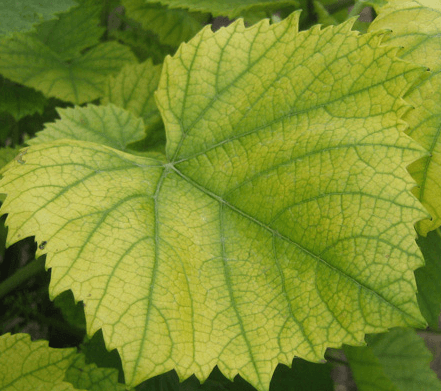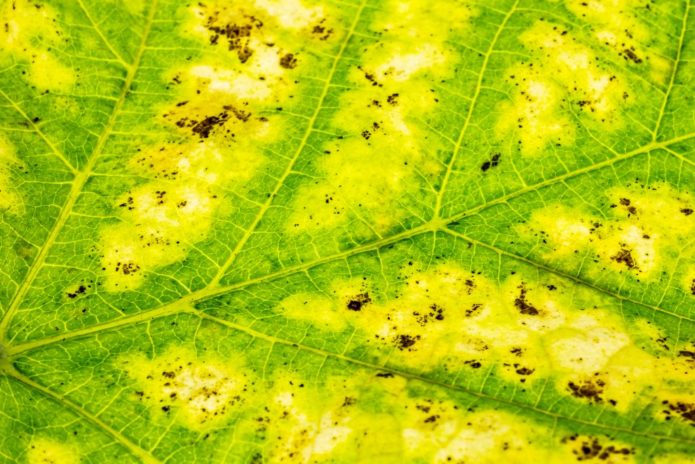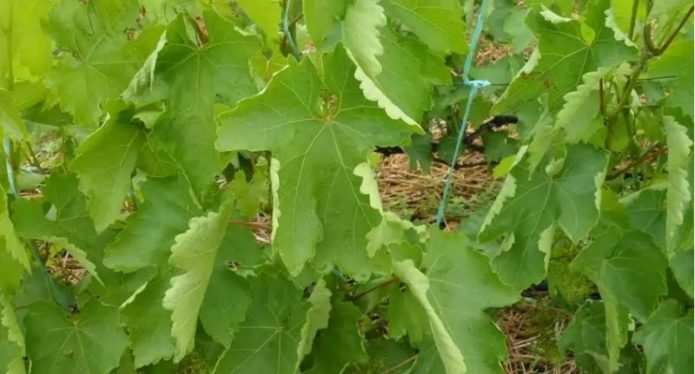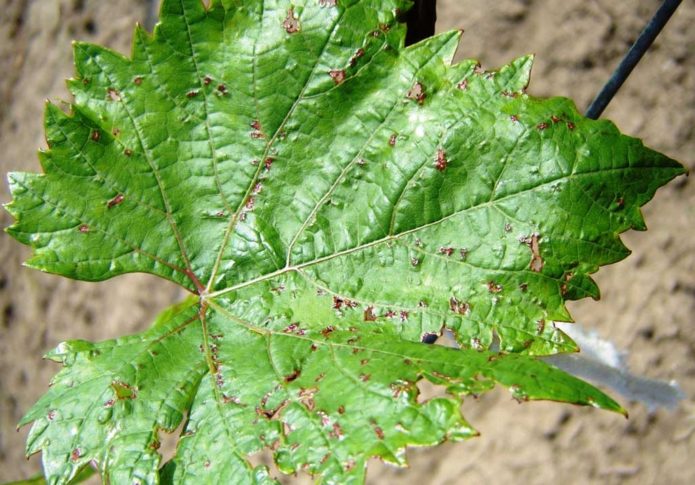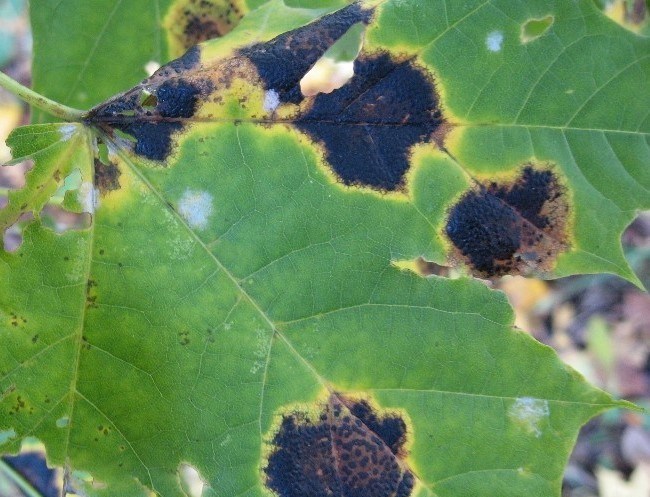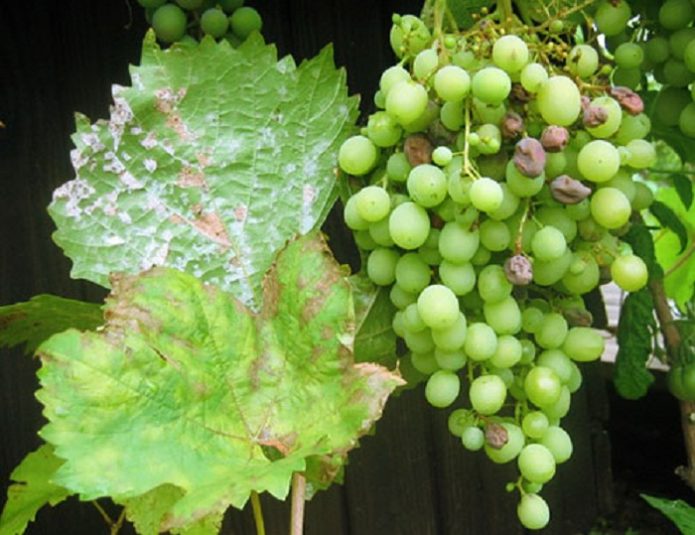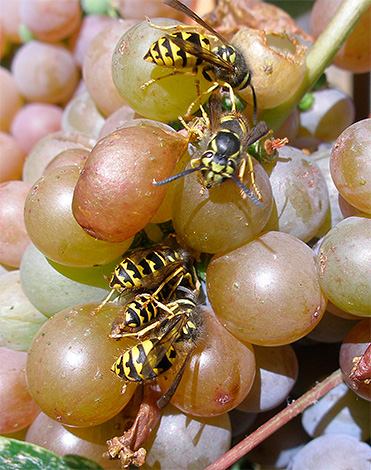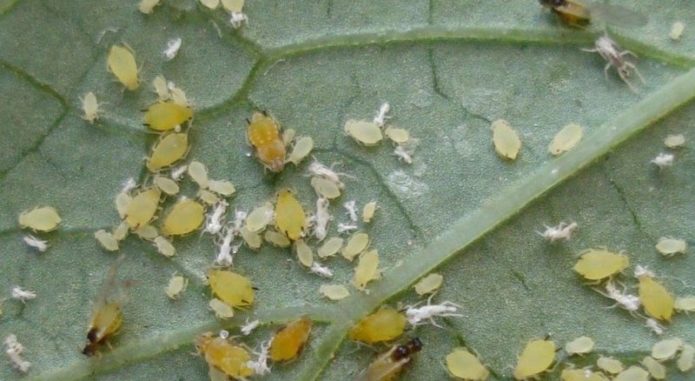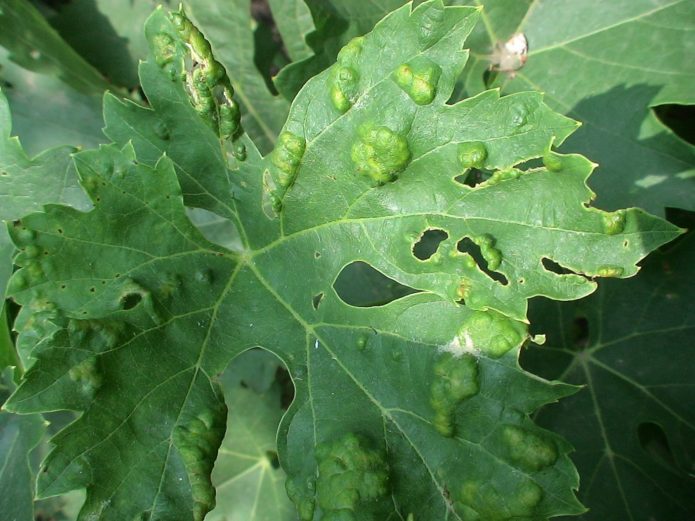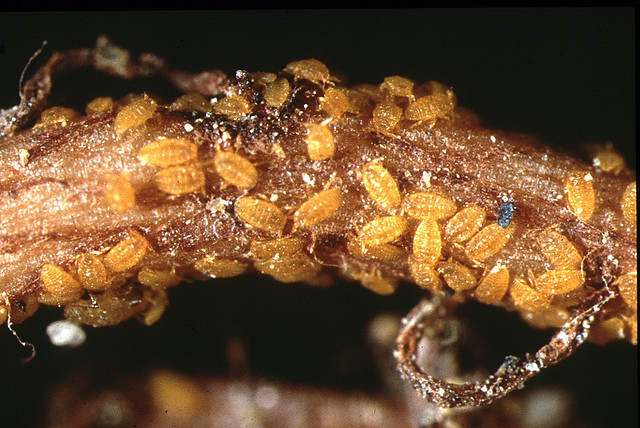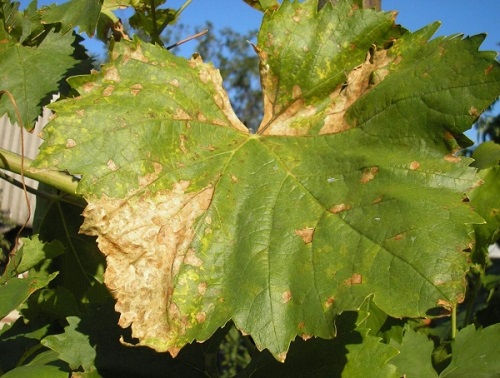Everyone who grows grapes on their site knows how much work goes into caring for this plant, and therefore must be able to cope with various diseases and pests. For the fight against diseases and pests of grapes to be most effective, you need to be able to recognize the symptoms and correctly select the necessary means of treatment.
Content
Types of diseases that grapes are susceptible to
There are many diseases that grapes can suffer from. You need to study their symptoms in order to be able to find the right treatment.
Non-infectious chlorosis
In the case of non-infectious chlorosis, the leaf blade of grapes first changes from dark green to light green. Then the leaves turn yellow and only the veins of the leaf and a small amount of tissue next to them remain green. Subsequently, the affected leaf dies off.
Non-infectious chlorosis affects not only the leaves, but the entire plant as a whole. The vine slows down its development, the growth point of the entire shrub dies off, the ovaries crumble. In addition, there is a great risk that diseased shrubs may not survive the winter.
The following varieties are most susceptible to non-infectious chlorosis: Don Agate, Italy, Magarach, Isabella, Pinot (black and blanc), Aligote. The least affected are Chasselas (white and pink), Saint Laurent, Muscatel, Pinot Meunier.
There can be several reasons for the occurrence of non-infectious chlorosis.
- unfavorable climatic conditions. Non-infectious chlorosis often results from cold, rainy weather;
- unsuitable soil. Grapes can get sick if they grow in airtight clay soil. The level of alkalinity of the soil also plays an important role. If the level is high enough (pH8 and above), then it will be difficult for your grapes to extract iron from the soil, which is necessary for the synthesis of the green pigment - chlorophyll, and to assimilate it, so the leaves will begin to change color and turn yellow.
Features and conditions for growing grape varieties for wine production:https://flowers.bigbadmole.com/en/yagody/vinograd/sorta-vinograda-dlya-vina.html
Treatment of non-infectious chlorosis
If you notice signs of non-infectious chlorosis on grapes, then take the following actions:
- Check the alkalinity of the soil. If the indicators are high, then adding ammonium sulfate salt to the soil at the rate of 100-150 g per bush will help you, as well as using a solution of ferrous sulfate. To make it, dissolve 50 g of powder in 10 liters of water. Spray the bush for 5 days. Remember to do this in the spring before bud break or in the fall after the foliage has fallen.If you need urgent treatment of the plant, then the concentration of the solution should be weaker, otherwise you risk burning the leaves. In this case, dilute 2–5 g of powder in 10 liters of water. Spray the plant for 5 days until the leaves regain their original color. It is advisable to do this procedure in the evening.
- In the spring, it is useful to spray with preparations containing iron in a chelated (transformable) form, for example, Fe Brexil, Iron Chelate, etc.
- Also, as a foliar feeding, preparations enriched with such macroelements as phosphorus and potassium are suitable (for a superphosphate solution, dilute 20 g of a pot in 10 l of water, for a solution of potassium sulfate - 5 g of powder per 10 l of water), as well as containing trace elements zinc, boron , manganese and magnesium (for example, a solution of marrgan sulfate - 4 g per 10 liters). They must be used simultaneously with chelating drugs.
- Improve soil quality. For this, an effective measure is a deep digging of the site. In this case, you remove excess moisture from the soil due to its evaporation. And if your site has heavy soil, then regularly loosen it and do not forget to make compost.
Infectious chlorosis
With infectious chlorosis (otherwise this disease is called yellow mosaic), grape leaves are covered with yellow spots, including veins. Infection of grapes with this ailment entails such consequences as peas (crushing) of berries, the death of leaves, and a decrease in frost resistance. In Russia, infectious chlorosis is more common in regions with a warm climate and mild winters.
The causes of this disease can be as follows:
- The presence of nematodes. Worms and their larvae are carriers of this disease. Nematodes settle on the stems, leaves and roots of the plant, causing the plant to become sick. Note that humid environments are most favorable for nematodes.
- Using an infected scion.
Unfortunately, grapes affected by the yellow mosaic cannot be treated. If you notice the symptoms of this disease on your grapes, then it is best for you to uproot and burn the bush, and treat the earth with a solution of ferrous sulfate (50 g per 10 liters of water).
Rolling the leaves
Curling vine leaves can be caused by both infection and unfavorable conditions.
- Infection. When infected, the grape leaves curl and dry out. The fruits become less sweet, decrease in size, and also change their color. All this inevitably leads to a decrease in the quality and quantity of the crop. Symptoms usually appear at the end of August, and if the bush is irrigated, then at the beginning of June. The leaves begin to curl inward. This primarily occurs with the leaves located at the base of the bush. Closer to the top, the leaves curl outward. Their color also changes: in white grape varieties, the leaves turn yellow, in colored varieties - red, while the veins remain green. Infection usually occurs through the graft, so try to use healthy graft material. Unfortunately, such a shrub is not amenable to treatment. You will need to destroy it immediately to avoid infecting other plants.
- Unfavourable conditions. These include insufficient humidity, hot dry weather and a lack of nutrients (potassium, nitrogen, sulfur, manganese). Control measures. This problem can be solved by providing the grapes with regular watering, as well as adding potassium sulfate (about 50 g per bush), ammonium nitrate (30 g per 10 L of water) or ammonium sulfate (40 g per 1 m2).
If the curling of the leaves started from the top of the bush, then this is a sign of a lack of nutrients, curling at the base indicates the presence of an infection.
Anthracnose
Anthracnose appears in the form of small brown rashes on leaves and shoots, which then merge into a large spot. The stain dries up and tears, so the leaves of the grapes appear perforated. This disease undermines the vital activity of the entire shrub, since it loses foliage and cannot produce the necessary substances with it.
If you are treating in the spring, then keep in mind that you can do this until the shoots reach a length of 10 cm.
How to treat anthracnose:
- Bordeaux liquid 3 is suitable for processing, after a week 1. You can spray the bushes only in the morning or in the evening.
- After twice applying Bordeaux liquid, use Previkur, Ordan or Fundazol for spraying every 10 days.
- In autumn after pruning or in spring before bud break, you can treat the shrub with a solution of DNOC (2.2%).
Fundazole has a wide range of applications, demonstrating effectiveness in the fight against various pathogens of fungal infections: https://flowers.bigbadmole.com/en/uhod-za-rasteniyami/fundazol-chem-ego-mozhno-zamenit-i-chto-eto-takoe.html
Black spot
Symptoms of black spot appear on different parts of the plant in May-June, towards the end of flowering, in the form of small black spots or chlorotic (gray-yellow) spots with a black center. The spots are formed along the veins of the leaf, gradually increasing in size. The spots have a light border of a light shade. The affected leaf becomes wavy to the touch, and then holes appear on it. Subsequently, the leaves fall off.
On shoots, especially annuals, the disease manifests itself as follows. First, dark dots or streaks appear on the nodes within the first 6–7 internodes. Then the dots grow and merge into large spots, which, in turn, spread and crack along the middle. The wood of the lower internodes becomes grayish white. If the disease has struck the trunk deep enough, then it can dry out. Also, with black spot, frost resistance decreases, and in winter the shrub can freeze.
As for the berries, the symptoms appear after ripening. The berries turn first brown, then purple, and then fall off. If you do not start treatment in a timely manner, then in 5-6 years the bush will die.
At the beginning of the disease, the symptoms of black spot can be confused with the lesion of the phyllocoptis tick. To distinguish them, examine the leaf against the light and through a magnifying glass: if the veins of the leaf converge in one place, and this spot has a yellow center, then the grapes are affected by a tick.
The disease is caused by a fungus that invades and spreads in the plant tissue, causing cell death. Spores of the fungus are transferred by drops of water.
The most resistant to black spot are Cabirnet-Sauvignon, Riesling, Relay, Tavrida. Least resistant Italy, Aligote, White Muscat, Chardonnay and Muscat grape variety Cardinal.
The treatment of grapes for this disease is long-term:
- When the first signs appear, remove the affected parts of the shrub and burn.
- Treat the shrub with a solution of sulfur or sulfur-containing preparations (Ditan, Poliram). This must be done between the swelling of the buds and the growth of shoots up to 10 cm.
- You can also treat the shrub with 1% Bordeaux liquid.
- In the autumn, after the foliage has fallen, treat the grapes with DNOC.
Scab
It manifests itself in the form of olive-colored rashes on the leaves, subsequently the rash becomes covered with a velvety bloom. The leaves shrink and die off, the ovary crumbles, and the fruits, if they ripen, become of different sizes, crack and become covered with the same spots. The following remedies can be used as treatment:
- Colloidal sulfur solution (100 g of powder per 10 l of water). Spray the shrub in the morning or evening when the sun is at its least active, otherwise the leaves can burn.
- Fundazol (10 g per 10 L of water) or Cuproscat in the same dosage.
Usually three treatments are enough, but if the disease is neglected, then their number can increase to five. It is also useful to feed grapes with ammonium nitrate (10 g of powder per 10 L of water) or ammonium sulfate (10 g per 10 L of water).
Oidium
Oidium, or powdery mildew, appears as a gray-white bloom that covers the leaves on both sides, and also affects inflorescences and berry clusters. The inflorescences fall off, and the berries become smaller and burst so that the bones become visible. The plant's frost resistance decreases and in winter it can die.
It is noted that a strong smell of rotten fish emanates from diseased plants.
Reason for appearance: powdery mildew is a fungal disease, the fungus lives on the surface of the shrub and its spores are easily carried by the wind, infecting plants. The incubation period of the disease takes no more than two weeks.
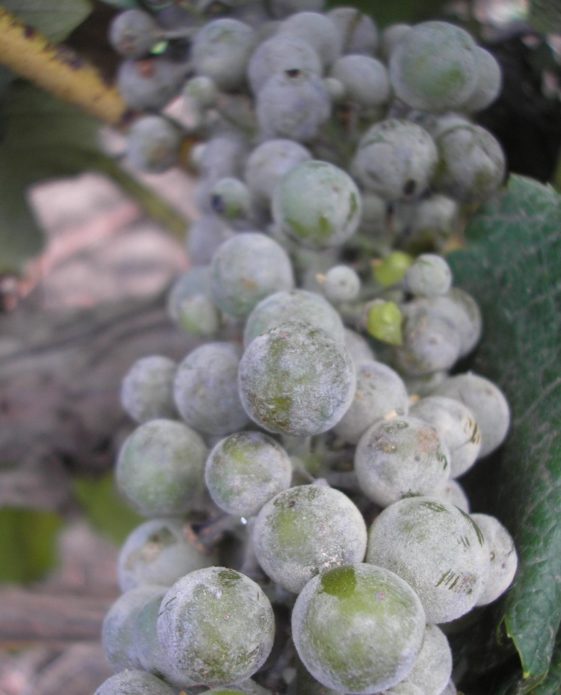
The defeat of grapes by powdery mildew significantly reduces the quality of the fruit and can lead to the death of the shrub
The most susceptible to powdery mildew are Chardonnay, Cabernet Sauvignon, Rkatsiteli. The varieties Aligote, Merlot, Semillon are relatively resistant.
Treatment:
- Powdery mildew is successfully treated with sulfur (colloidal can be used). To prepare the solution, dilute 100 g of powder in 10 liters of water. Remember that spraying is necessary in the morning or evening, when the sun is least active, otherwise you risk burning the leaves. The temperature at the time of the procedure should be at least +20aboutC. Repeat the treatment of the bush every 10–20 days until healed.
- Also, gardeners often use humus infusion to combat this disease. It is done like this: one-third of a one-liter barrel is filled with humus, water is poured at a temperature of +25aboutC, cover with burlap and leave for 6 days, stirring regularly. The resulting solution must be filtered, and then sprayed with shrubs with it in cloudy weather or in the evening. Re-processing is carried out in a week.
- If you want to use a special preparation, then treat your affected shrub with Fundazol, Topaz, Tiovit, preparing it according to the instructions. As a rule, two treatments at intervals of a week are sufficient. But remember that chemicals cannot be used during the ripening period of the berries, so at this time spray the bushes with a solution of potassium permanganate to contain the disease.
Video: oidium in the vineyard
Mildew
Mildew, or downy mildew, is one of the most common and dangerous fungal diseases of grapes. The main symptom is the formation of oily yellow spots, which then turn brown on the outside of the leaf and white bloom on the inside, but this may not appear in dry weather. Infected inflorescences turn yellow and curl, and then dry up. The berries are much smaller.
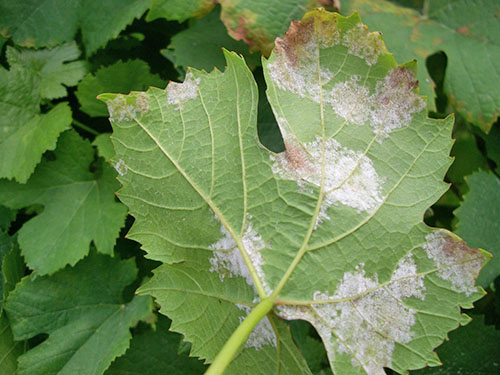
In case of mildew infection, the leaves of the grapes are covered with a white coating on the inside.
Treatment
One of the most effective mildew treatments is a mixture of Bordeaux liquid and lime mortar. The concentration of copper sulfate depends on the spraying time: before the buds open, a 3 percent composition is used, in a later period - 1 percent. The solution is prepared as follows: dilute 100 (300) g of copper sulfate in 5 liters of hot water, dilute 75 g of quicklime and 10 liters of water in a separate bowl, and then mix both compositions, strain and process the shrub, paying particular attention to the back of the leaves. If it rains shortly after the procedure, repeat the treatment.
Of the drugs for fighting mildew, Kuprozan, Antrakol, Kuproksat are suitable. Keep in mind that, if effective enough, they can also slow down shrub development.
Blackleg
Blackleg is a fungal disease. Grapes can be damaged if you plant them in contaminated soil. It is manifested by the fact that the shoot turns black from below and looks stained, it can soften. Young plantings suffer the most. From the stem, the disease spreads to other parts of the plant, and in grapes the leaves may begin to turn yellow and the stalks rot.
Treatment: the fungus multiplies well in a humid environment, so adjust the amount of watering, and also dry the soil (dig up, loosen and sprinkle with ash), water the plants with a solution with the addition of Energen 10 g per 10 l of water or Hom 4 g per 10 l of water.
Video: mildew in the vineyard
Damage to grapes by pests
Grapes suffer not only from infectious and fungal diseases, but also from a variety of parasites. To successfully fight them, you need to know the symptoms of a bush affection by a specific pest.
Wasps
Wasps are a common grape pest, and it is possible that you will find berries bitten by them on your bush. Usually, these insects do not finish the berry, and, having spoiled one, move on to the next, so even a small number of pests can spoil a significant part of the crop.
Wasp control measures are as follows:
- Destruction of the wasp nest. This activity is best done in low light conditions (late evening, night or early morning) when insects are least active. Spray the nest with a poisonous substance (Dichlorvos, Raptor, Reid), after 20-30 minutes, carefully put it into a sealed container and burn it. Please note that for this event you need to wear tight clothing that completely covers your body and protect your face, for example, with a net.
- Use of protective bags. If there is no nest nearby, then you can protect the grape clusters by putting on special fabric bags in a small cell. The advantage of this method is that in this way you will also save the grapes from birds. The downside is the high labor intensity of the event, so this method is best used in small areas with a small number of grape bushes.
- Manufacturing poison. You can place flat dishes with diluted honey or jam mixed with Regent or Aktara (per 100 g of product, 1 g of pearate) next to the bushes.
Mites
There are several types of mites that can damage your grapes. Infection with ticks causes slow growth and development of shrubs, destruction of young shoots, and a decrease in the quality and quantity (by 20–50%) of the crop.
Spider mite
The main signs of this pest include the presence of red, silvery and pale yellow spots on the outside of the leaves, as well as the appearance of membranes between the leaf and the stem.
Tick treatment:
- If you find signs of a spider mite on your bush, then first tear off all the affected leaves and, if possible, remove the diseased bark, and then burn it.
- It is also necessary to treat the shrub with special preparations. In the spring, when the buds are blooming, use DNOC (for 1–2 liters, 50–100 g of powder is taken, thoroughly mixed and diluted in 10 liters of water), and at the end of this period - with a 0.02% acaricidal preparation (Apollo, Masai). Spray every 14 days until the parasites are completely eradicated, alternating preparations, because the mite can get used to them.
Felt grape mite
If you notice red swells and bumps on the outside of the grape leaves, and brown spots on the inside, then this indicates that a felt mite has wound up on your bush.
Treatment:
- Remove affected leaves and shoots from the bush
- Treat the grapes with the following preparations, paying special attention to the inside of the leaf if you use them in the summer:
- Colloidal sulfur solution. It is used for the growth of shoots by 5 cm and at a temperature not lower than 20s. To prepare the solution, dilute 100 g of powder in 10 liters of water. Please note that this solution affects only adult insects, therefore, carry out one more treatment with a special preparation (Apollo, Neoron, Fitover) in the fall after leaf fall.
- Special preparations (Apollo, Neoron, Fitover) prepared according to the instructions. But keep in mind that it is undesirable to use them during the ripening period.
- DNOC. Used in spring (before bud break) or autumn (after leaf fall). Prepare in the usual way.
Red tick
If this pest has wound up on your grapes, the leaves will acquire a bronze tint. Treatment is reduced to removing all affected leaves and treating the shrub with a sulfur solution or a special device, as in the fight against other mites.
Phylloxera
Phyloxera, or grape aphid, is one of the most dangerous pests of grapes. An unpleasant feature of this pest is its rapid spread throughout the vineyard.
If you want to protect grapes from phylloxera, then choose sandy or sandy loam soil for planting - the parasite cannot live in them.
- Underground. It is considered a more dangerous pest than leaf. It lives on the roots of grapes at a depth of about 0.5 m. The insect bites through the root and draws out nutrients from it, and a swelling or outgrowth forms at the root of the bite. Because of this, the root ceases to function normally and dies off, and with it the whole bush. Since these pests clearly do not manifest themselves, you should be wary if the grape bush began to slowly develop and wither.
- Leafy. The main sign of defeat by this pest is the appearance of swelling on the grape leaves from the outside and yellow rashes from the inside. Control measures for underground phylloxera include removing (if possible) the affected root areas and treating the soil with carbon disulfide. Unfortunately, there are no uniform dosage recommendations. So, for example, applying for 1 m2 soil 80 g of the substance is harmless to the plant, but it may also be insufficient for the extermination of parasites, increasing the dosage of the drug to 300-400 g will destroy phylloxera, however, the shrub itself may die, since hydrogen sulfide is highly toxic. Still, it is recommended to carry out such treatment in order to avoid contamination of other shrubs.
You can also fight phylloxera with the help of Fozalon, Kimnix (suitable for both types of phylloxera), Actellik. They are especially suitable for small vineyards.
Actellic has fumigating properties, evaporating, the liquid penetrates the respiratory organs of insects and poisonous vapors kill the pest:https://flowers.bigbadmole.com/en/uhod-za-rasteniyami/udobreniya/instrukciya-po-primeneniyu-aktellik-otzyvy-o-preparate.html
Other grape problems
In addition to disease, there are several other problems that you may encounter in the process of growing grapes.
Gnawing with mice
Rodents often use grape shrubs as food during the winter. The most dangerous are plantations located near forests or fields where sunflowers or grain crops were grown in summer.
You may find that your grapes are spoiled by mice after freeing the bush from their winter shelter. If such a situation has occurred, then the first step is to assess the scale of the damage.
Most often, mice damage relatively young shoots rather than perennial stems and sleeves.
Some fruit vines are damaged.Remove shoots with completely nibbled bark and eaten eyes, but try to leave buds at the very base of such a shoot. Later, new shoots will grow from these buds, and you can form new fruit vines on them.
Some parts of the fruit vine are damaged. Trim the most damaged areas, including those where there are no whole buds left. Please note that even a short-cut vine can grow a crop, and form a vine on newly grown shoots.
Sprinkling grapes
This can happen for several reasons.
- Features of the variety. When ripe, grapes of some varieties can crumble (Ukrainka, Rusbol). Therefore, carefully study the information regarding the variety that you are going to plant.
- Lack of trace elements in the soil. If the soil is poor in nutrients, then this problem can be eliminated with the help of ash - add it to the soil during weeding or in the spring when digging. In August, the use of an ash solution of 2 kg per 10 liters will help you, infuse from 1 to 7 days. 1 time in 10 days before autumn leaf fall.
Bark cracking
If you notice cracks in your grapes going along the trunk, then you should not worry, as this is due to the natural growth process of wood.
To avoid getting an infection, do the following:
- Treat wounds with a 3% or 5% solution of copper sulfate.
- If you live in a cold climate, then insulate the shrubs with burlap for the winter.
Drying leaves
This can happen with a lack of nitrogen. If you are faced with this problem, then feed the shrub with ammonium nitrate at the rate of 30 g per 10 liters of water.
Drying or rotting vines
This situation can arise when freeing a bush from a winter shelter. In this case, take a square of roofing material (1 side - 50 cm), cut a hole with a diameter of 10 cm in the center. Excavate the shoots to the heel roots, cover them with roofing material and pour with a solution with the addition of a growth stimulant.
A calendar for protecting grapes from damage
You can protect grapes from damage according to the following calendar:
- First treatment: carried out in the spring, until the shoots have reached 10 cm in length. Preparations: Tiovit Jet (100 g) + Abiga Peak (40 ml) + 10 liters of water. This mixture will enrich the grapes with sulfur and copper, which are the least effective pest control agents.
- Second treatment: carried out 3 weeks after the first. Thanks to them, you will completely protect the grapes from anthracnose.
- Third treatment: carried out just before flowering. Mix Cabrio Top (30 g) and Actar (4 g) in 10 liters of water. The validity period is about two weeks.
- Fourth treatment: try not to tighten, as the ovary is not protected and is an easy prey for pests and infections. It is necessary to treat the grapes with Cabrio Top solution with the same dosage.
- The fifth treatment: carried out after 10-12 days, the berries are already pea-sized. Make this mixture: Ridomil Gold (30 g) + Topsin M (20 g) + Aktara (4 g) + 10 L of water.
- Sixth treatment: carried out after 14 days. Required solution: Thanos (4 g) + Topaz (4 ml) + 10 liters of water. These preparations do not leave marks on the berries.
Summing up, we can say that although the treatment of grapes will require a lot of effort from you, with the correct implementation of all medical measures and timely preventive treatment, you have every chance to preserve your shrub and ensure its healthy development.
